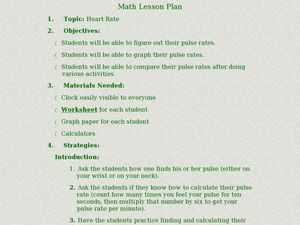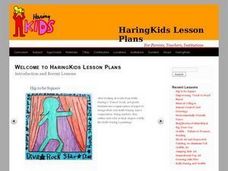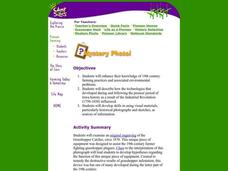Curated OER
Yeast Cells and Their Environment
Students create their own experiment in which they have yeast cells growing in liquid environments. They examine the relationship between humans and microorganisms. They also practice using the scientific method.
Curated OER
FLY HIGH!!!
Students create their own bird study in their own schoolyard using the scientific method (see Testing a Hypothesis in Join the Project). Students do research in the library, at a local college, or on the Internet to determine the...
Curated OER
Investigating the Biosphere with Planetary Models
Students model the biosphere and manipulate variables affecting change and plan their experiments with the help of others. They describe their question, hypothesis, and methods of investigation.
Curated OER
How to Construct and Conduct Successful Interviews
Students conduct surveys to gain statistical information. They examine the four main types of surveys and three types of samples. Students create a practice survey, conduct field studies, and create a survey for their hometown. Students...
Curated OER
State Economy Chart
Fifth graders create a 3D Pie graph using the Chart Wizard in Excel to represent their assigned states' data. They discuss the similarities and differences between states, and form a hypothesis on the relationship between location and...
Curated OER
Struggle for Existence and Population Growth in Aphids
Students examine the population of aphids. They identify adaptations they have made for their environment. They make predictions, test their hypothesis and collect information that either proves or disproves their theory.
Curated OER
Graphing Heart Rates
Young scholars explore heart rates. They record pulse rates, predict which exercises cause a faster heart rate, make a chart, and graph the results. Students write an essay using the data to support their predictions. They write a...
Curated OER
Subject Selection in Clinical Trials
High schoolers design and conduct an experiment to test a hypothesis. They create a question/objective based on the results of their experiment that can be answered by performing a human clinical trial. Students write inclusion and...
Curated OER
Daily Survival Requirements of Water
Students will use inquiry science to complete an investigation. They create hypotheses predicting the changes water undergoes in becoming ice and determine how much ice needs to be melted to create one 8 oz. glass of water.
Curated OER
Shellfish Shenanigans
Twelfth graders create simulations of a reality-based TV show that investigates the near death of a contestant from a seafood meal. They examine the physical symptoms of anaphylactic shock, and create protein fingerprints.
Curated OER
Mixing Up Magic
Students explore the relationship between art and science through experimenting with color, design and recycled materials and creating their own art work.
Curated OER
WEATHER SATELLITE PREDICTION PROJECT
Students compile weather satellite data from three satellites for one month, obtain weather reports and data from professionals, then create a document with predicted results.
Curated OER
Watershed Awareness
Students investigate the relationship between upstream influences in their watershed and the watershed's estuary. They apply the scientific process to test a hypothesis while examining the impact of upland activities on estuaries.
Curated OER
Social Studies: Chinese Migration to America
Students examine human migrations and hypothesize why Chinese immigrants came to the Pacific Northwest. In groups, they research reasons for the migration and record them on a Venn Diagram with general migratory reasons. Students...
Curated OER
Measurement: When Degrees Matter
Eighth graders record the temperature change of the beakers. For this general science lesson, 8th graders create their own data table for recording observations. They discuss experimental results and cite real life applications.
Curated OER
Change slander to remorse: Unscripted Scenes
Students hypothesize about the content of unscripted moments, search for evidence in the actual text to support their hypothesis, and explore how this hypothesis would affect characterization.
Curated OER
Mystery Photo!
Students examine an original engraving of a piece of equipment called, The Grasshopper Catcher. They describe how technologies developed in Iowa during the Industrial Revolution influenced farming practices, and develop hypotheses about...
Curated OER
Don't Trust Your Eyes
Students brainstorm a list of possible actions that they could do to protect the water resources from pollution. They create hypotheses and conclusions by completing experiments and observing different pollutants.
Curated OER
Optional Laboratory: Comparing Soil Temperatures In Sun and Shade
Learners work together to test the temperatures of different soils in shade and sun. They make their own hypothesis before beginning the experiment. They record their data and discuss as a class.
Curated OER
Optional Laboratory: Calculating Board Footage in a Tree
Students work together to complete an experiment calculating the amount of board footage in a tree. They record their data and answer questions at the end of the lesson plan. They create their own hypothesis as well.
Curated OER
The Effects of Ultra-Violet Light on Yeast
Students work in small groups collecting and analyzing data as they learn how to best grow yeast. This activity allows students to conduct several student-created experiments as they continually generate questions and hypotheses. ...
Curated OER
Am I Neutral? pH Properties in Soil
Students participate in a science lab to determine the pH of three different soil samples. Students conduct an experiment by creating a question, a hypothesis and then an investigation of soil samples. Then they compare colors apprearing...
Curated OER
Treasure of the Tar
Students use the Canadian Atlas to discover the natural resources available in various areas of the country. Using the region known as the "Tar Sands", they identify the area's characteristics and develop hypothesis about the future...
Curated OER
Butterfly Life Cycle
Third graders investigate the life cycle and development of butterflies. They complete an online WebQuest, and write journal entries about their research information. Students create a poster, and observe real Painted Lady larvae...























